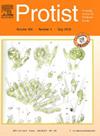两种淡水Frontonia (Ciliophora, Peniculida)的分类、地理分布和分子系统发育,包括一种新隐种Frontonia pareucas sp. nov。
IF 2.1
3区 生物学
Q4 MICROBIOLOGY
引用次数: 0
摘要
纤毛虫属Frontonia是青霉菌目中物种最丰富的类群之一,广泛分布于各种栖息地。然而,分离株的定义和鉴定是具有挑战性的,因为很少有可靠的特征,而且这些特征可能在同系物中重叠。在本研究中,我们描述了两个容易混淆的物种,包括新形式F. pareucas sp. 11和F. paramagna Chen et al., 2014。这两个物种的形态特征与该属的模式种F. leucas (Ehrenberg, 1833) Ehrenberg, 1838中观察到的相似。此外,以F. leucas命名的不同分离株之间序列的显著差异表明存在隐藏或错误识别的物质,这些序列代表了一个复杂的群体而不是一个单一的物种。对GenBank中分离的F. leucas和F. paramagna的SSU rRNA基因序列进行了仔细的检验,确认该序列(AM072622)为真品。新发现的物种,f.p aleucas sp. nov.,连同f.f leucas和f.c.f leucas,构成f.f leucas物种复合体。对这些分类群地理分布的分析,结合历史记录,揭示了一个不平衡的全球格局。该研究强调了整合分子和形态数据对准确识别物种的重要性,并为Frontonia属的隐多样性和分类提供了新的见解。本文章由计算机程序翻译,如有差异,请以英文原文为准。
Taxonomy, geographic distribution and molecular phylogeny of two freshwater Frontonia (Ciliophora, Peniculida), including a new cryptic species Frontonia paraleucas sp. nov.
The ciliate genus Frontonia, one of the most species-rich groups of the order Peniculida, is widely distributed across a variety of habitats. However, the definition and identification of isolates are challenging, as there are few reliable characters, and these may overlap among congeners. In the present study, we describe two easily confused species, including a new form F. paraleucas sp. nov. and F. paramagna Chen et al., 2014. Both species exhibit morphological characteristics similar to those observed in F. leucas (Ehrenberg, 1833) Ehrenberg, 1838, the type species of the genus. Furthermore, the substantial divergence of sequences among different isolates under the name of F. leucas, indicates the existence of cryptic or misidentified material and that such sequences represent a complex group rather than a single species. A meticulous examination was conducted to ascertain the reliability of the SSU rRNA gene sequences of isolates designated as F. leucas and F. paramagna in GenBank, and it was confirmed that the sequence (AM072622) represented the authentic F. leucas. The newly described species, F. paraleucas sp. nov., along with F. leucas and F. cf. leucas, constitute the F. leucas species complex. Analysis of the geographic distribution of these taxa, combined with historical records, reveals an uneven global pattern. This study emphasizes the importance of integrating molecular and morphological data to accurately identify species, and provides new insights into cryptic diversity and classification within the genus Frontonia.
求助全文
通过发布文献求助,成功后即可免费获取论文全文。
去求助
来源期刊

Protist
生物-微生物学
CiteScore
3.60
自引率
4.00%
发文量
43
审稿时长
18.7 weeks
期刊介绍:
Protist is the international forum for reporting substantial and novel findings in any area of research on protists. The criteria for acceptance of manuscripts are scientific excellence, significance, and interest for a broad readership. Suitable subject areas include: molecular, cell and developmental biology, biochemistry, systematics and phylogeny, and ecology of protists. Both autotrophic and heterotrophic protists as well as parasites are covered. The journal publishes original papers, short historical perspectives and includes a news and views section.
 求助内容:
求助内容: 应助结果提醒方式:
应助结果提醒方式:


